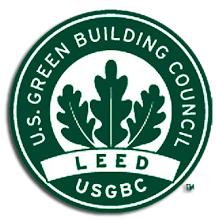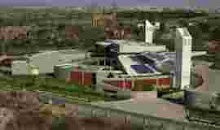The LEED for Schools Rating System recognizes the unique nature of the design and construction of K-12 schools. Based on the LEED for New Construction rating system, it addresses issues such as classroom acoustics, master planning, mold prevention and environmental site assessment.
By addressing the uniqueness of school spaces and children’s health issues, LEED for Schools provides a unique, comprehensive tool for schools that wish to build green, with measurable results. LEED for Schools is the recognized third-party standard for high-performance schools that are healthy for students, comfortable for teachers, and cost-effective.
Green School Buildings Web site
Green schools are healthy for students, teachers and the environment. Built right, green schools are productive learning environments with ample natural light, high-quality acoustics and air that is safe to breathe. Schools everywhere are going green, nurturing children while saving money. Get the facts and learn how you can make the case to green your community's new and existing schools.
Learn more about what you can do to help promote green schools in your community. Visit USGBC's green schools Web site, GreenSchoolBuildings.org »
LEED v3
LEED v3 launched on April 27, 2009, including an upgrade of LEED for Schools under the suite of LEED 2009 rating systems. LEED for Schools 2009 is served by the Green Building Design and Construction Reference Guide.
LEED 2009 for Schools New Construction and Major Renovations Rating System » (PDF)
The Rating System lists the intent, requirements, and technologies & strategies for each credit. Updated April 14, 2010.
LEED 2009 for Schools New Construction and Major Renovations Checklist » (XLS)
The Checklist helps project teams track their credits against requirements for certification.
Rating System & Reference Guide Addenda » Project teams are required to adhere to the Rating System addenda based on registration date; it is strongly recommended that project teams adhere to the Reference Guide addenda based on registration date.
LEED 2009 for Schools Resources & Tools »
Additional resources and tools that pertain to LEED 2009 for Schools project teams.
Version 2007
2007 Rating System (PDF)
The Rating System lists the intent, requirements, submittals and technologies/strategies for each credit and includes the Project Checklist. All LEED for Schools projects are required to achieve the new EAc1 two point mandatory minimum.
2007 Project Checklist (PDF)
The Checklist helps project teams track their credits against requirements for certification.
v2007 Errata Sheet (PDF)
Project teams are subject to errata requirements based on registration date.
LEED for Schools 2007 Resources & Tools »
Additional resources and tools that pertain to LEED for Schools 2007 project teams.
LEED for Multiple Buildings
LEED 2009 Projects
The 2005 Application Guide for Multiple Buildings and On-Campus Projects was written prior to the release of LEED Online, and was intended to be used only with LEED NCv2.1 and NCv2.2. The document was also written for a paper-based certification process. Though the guide contains valuable information regarding technical approaches to LEED credits in multiple-building scenarios, the document is somewhat outdated and does not adequately address application procedures for projects using LEED Online.
GBCI’s planned update (anticipated in late Q2 2010) to the Certification Policy Manual will clarify policies and procedures regarding certification of multiple-building and campus projects for all versions of LEED (including both LEED 2009 and previous versions). The update will include significant modifications to the methodology for LEED certification in a multiple building context, as well as opportunities for streamlining documentation and review of multiple building and campus projects.
In order to ensure the smoothest possible certification process, it is recommended that project teams wait to submit any multiple building applications until updates to the policy manual are published. Project teams with scheduling constraints that cannot be avoided which require application in advance of the policy manual updates should contact GBCI.
Note: For LEED 2009, all buildings must be registered individually. LEED 2009 multiple building projects are encouraged to first register a Block. Each building must then be registered separately from within the Block. See the Help section of LEED Online for more information on blocks.
Version 2 Projects
The existing LEED-NC Application Guide for Multiple Buildings and On-Campus Buildings (AGMBC – published in October 2005) provides direction in applying LEED for New Construction to projects in a campus or multi-building setting such as corporate campuses, college campuses and government installations (i.e., a single owner or common property management and control). It is intended for projects where either several buildings are constructed at once or in phases, or a single building is constructed in a setting of existing buildings with common ownership or planning with the ability to share amenities or common design features.
GBCI’s planned update (anticipated in late Q2 2010) to the Certification Policy Manual will clarify policies and procedures regarding certification of multiple-building and campus projects for all versions of LEED (including both LEED 2009 and previous versions). The update will include significant modifications to the methodology for LEED certification in a multiple building context, as well as opportunities for streamlining documentation and review of multiple building and campus projects.
Pre-LEED 2009 Projects may elect to wait for the publication of the update to the Certification Policy Manual, or they may choose to apply the existing LEED-NC Application Guide for Multiple Buildings and On-Campus Buildings to their project.
Should you have any questions regarding your multiple building submission please contact GBCI via theContact us page.
LEED for Multiple Buildings and On-Campus Building Application Guide (PDF)
Source
ertification LEED India certification provides independent, third-party verification that a building project meets the highest performance standards. The LEED India plaque awarded by the IGBC is a recognition of the project achievement. Benefits of certification : LEED-INDIA-certified buildings: * are leading the transformation of the built environment Certification Process: * Registration Registration: The first step toward earning LEED-INDIA certification is project registration. Registering during the early phases of project design will ensure maximum potential for achieving certification. Registration is an important step that establishes contact with the IGBC and provides access to essential information, software tools and communications. Upon registration, project contacts receive LEED India templates and a Reference guide. To register your projects visit the LEED-INDIA Registration page. Once a project is registered, the project team begins to prepare documentation and calculations to satisfy the prerequisite and credit submittal requirements. It is helpful to have a IGBC Accredited Professional as the project contact and team member responsible for coordinating the LEED-INDIA process and requirements. Credit Interpretations: In some cases, project teams may encounter difficulties applying a LEED India prerequisite or credit to a specific project. In such cases, projects can apply for Credit Interpretation Request (CIR) If a question arises, project teams should : * Consult the LEED India Reference Guide in regards to credit intent, requirements and calculations. * Review the LEED India Credit Interpretations Rulings (CIR) page for previously logged CIRs on relevant credits. The inquiry should be brief and based on information found in the reference guide, with emphasis on the intent of the prerequisite or credit. Note: For projects the first two CIRs are included with registration. For each additional CIR, projects need to pay Rs.5000/- Certification and Documentation: To earn LEED India certification, the applicant project must satisfy all of the prerequisites and a minimum number of points to attain a LEED India rating level. The certification review process includes the following: 1) Documentation Submittal The project team submits two complete copies of ALL project documentation (in CD) and the corresponding fee (cheque payable to Confederation of Indian Industry) sent to: CII-Godrej Green Business Centre, A complete documentation includes the following: * Project brief including the following:
2) LEED India Reviews: * Preliminary Review: The IGBC conducts a Final LEED India Review of the documentation within 30 working days of receiving the resubmittal and notifies the project about the certification status. To ensure implementation of all features considered during the design stage, IGBC will henceforth carry out physical verification in two phases:
3) Acceptance of Certification Award: Upon communication of the LEED India certification, the project team has 15 working days to accept or appeal the awarded certification. Upon the project`s acceptance, or if it has not appealed the rating within 30 days, the LEED India certification is final. The project may then be referred to as a LEED India certified building. The IGBC presents the project team with an award letter, certificate and metal LEED India plaque indicating the certification level. 4) Appeal: If the project team feels that sufficient grounds exist to appeal a credit denied in the Final LEED India Review, it has the option to appeal. The appeal fee is Rs.20,000 per credit appealed. A review of these items will occur within 30 working days after which, an Appeal LEED India Review will be issued to the project Appeal Submittals If an appeal is pursued, please note that a different review team will be assessing the appeal documentation. Hence, be sure to include the following information: * Project brief including the following:
Please submit two copies of the appeal information (in a compact disc) to LEED India Certification Manager at the IGBC. Remember to include a Cheque/ DD, on favour of Confederation of Indian Industry payable at Hyderabad, @ Rs.20,000 per credit or prerequisite appealed. IGBC will complete your Appeal LEED India Review within one month from receipt of your resubmittal. Fee Summary
* Parking areas need not be considered as part of the built-up area * Fee is inclusive of sevice tax * Registration and Certification fee are non-refundable * Membership discounts can be availed only if the project owner is a member of IGBC | ||||||||||||||||||||||||||||||||||||
Source
 Site plan
Site plan


No comments:
Post a Comment